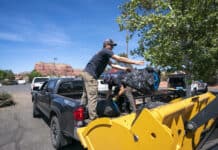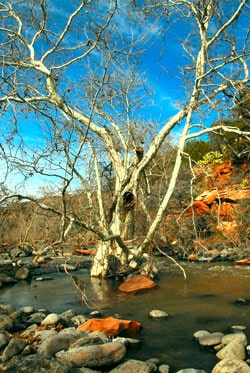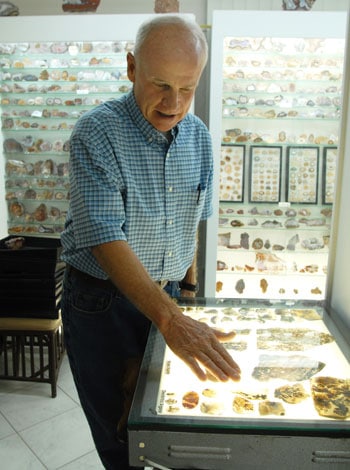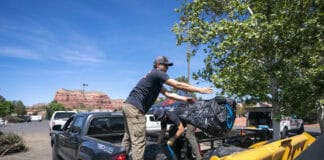Red Tank Draw is not for the faint of heart.
But for those who want a real archaeological adventure in a rugged and lonely location, this is the real thing.
It’s necessary to wear sturdy hiking boots for protection against several things: the huge vigorous prickly pear cactus that populate this area, startled rattlesnakes that sometimes sun themselves here and turning an ankle between the numerous misshapen stones, rocks and boulders.
A hiking stick is also a good idea not just for balance but to hold catclaw acacia and other thorny vegetation at a distance.
Binoculars are helpful too, helping to spot panels worth the investment in scrambling up the talus slopes.
Due to the challenging terrain and lack of frequent visitors, it’s a good idea not to travel here alone in case of an accident requiring someone to go for help.
The draw itself is a deep wash draining into Wet Beaver Creek, sometimes carrying cold, tumbling snow melt, coursing over sheer drops, washing over large boulders and around deep-rooted, sprawling sycamore trees.
Beautiful to see and hear, the hectoring water sometimes makes it difficult or impossible to navigate in certain places along the streambed, and visitors will be limited in what they can see.
More typically, the wash is dry, allowing unrestricted access to rock walls on both sides of the draw that are filled with petroglyphs.
For some, the lack of a dictionary defining each of the hundreds of drawings found here is frustrating.
Others find reward in the mystery of their meanings and the opportunity to speculate and to time-travel back to prehistory, if only vicariously.
While some of the petroglyphs are hard to miss, others are hidden on panels that have fallen or still stand high near the rim, requiring the sure-footedness of a mountain goat.
When choosing to climb to these sites, it’s recommended not to put hands and feet into crevices that might already be occupied by territorial wildlife.
Petroglyphs are the main attraction but multicolored lichens growing on the sheer rock walls can be found here as well, some forming designs as intriguing as the etchings.
As ancient as the rock art, lichens are the unlikely combination of a fungus and an algae (although sometimes a fungus and a cyanobacterium).
Occurring in some of the most extreme environments in the world, these organisms are able to suspend their metabolism in times of severe drought, yet are sensitive to industrial pollution.
American Indians sometimes used them to make dyes and they’ve also been used to treat wounds.
On occasion, hikers traversing the draw will thrill to the high-pitched trills of red spotted toads.
Lovelorn males audition for mates during the breeding season running from March through September.
A view of Casner Butte and the remote landscapes to the east offer further rewards for making the relatively short but bumpy drive to the draw.






















